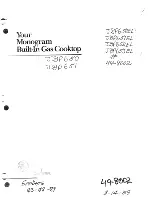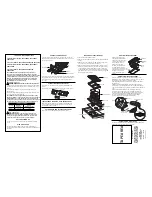
GWS 457.0
21
Gas connection
First check whether you have the right type of gas and the right gas supply
pressure. You will find the details of the gas supply pressure in the section
“Technical data” (p. 24).
The adhesive label (which is located on the bottom of the appliance) indicates
for what type of gas the built-in hob has been adjusted.
It is possible to convert to another type of gas; this is explained in these
operating and installation instructions under “Converting to a different type of
gas” (p. 21).
The pipe for the gas connection is at the centre of the underside of the
appliance.
The R 1/2" gas connection required can either be a permanent connection by
means of a main cock in accordance with DIN 3354 or a DVGW (German Gas
and Water Association)-authorised gas safety hose with a socket (DIN 3383,
Sheet 1).
It must be ensured that the connection parts are laid in such a manner that
they cannot heat up and become damaged while the appliance is in operation
and that they cannot come into contact with the movable parts of the kitchen
elements.
Electrical connection
An earthed shockproof socket is required for electrical connection. Electrical
connection must be carried out in conformity with the VDE guidelines. The
appliance has been constructed for a mains supply of 220-240 V / 50 Hz.
Power consumption is less than 20 watts.
The connection cables must be laid in such a way that they do not heat up
and become damaged when the appliance is in operation.
Converting to a different type of
gas
This appliance can be converted to run on other types of gas.
[
Adjustment and conversion work should only be carried out by a qualified
gas fitter! The applicable rules and regulations should be observed.
Disconnect the appliance from the power supply so that it is completely
free of voltage.
[
The type of gas and the gas supply pressure must correspond to the gas
setting specified on the appliance. The factory setting is indicated on an
information plate or on the identification plate.
[
Any subsequent conversions to different types of gas must be
permanently marked on the nameplate of the appliance.
[
Use only the special injectors which can be ordered from Customer
Service.
[
On adapting to another type of gas it is essential that the full flame and
low flame injectors are replaced; see as follows in this instruction manual.
Prior to any adjustment, the supply of gas and electricity must be cut off.
Diameter of injectors
[
Attention:
Only use special injectors obtained frome the customer
service! The values in the table are stamped on the injectors! The use of
larger injectors than those approved for the gas/connection pressure
results in failure of the appliance and damage to the user’s health
(CO emission)!
Conversion injector sets
Injector specification full flame injector / low flame injector
Gas type
Inner burner
Outer burner
Natural gas H, E, E+
G 20 (20/25 mbar)
Y / 36
173 / 74
Natural gas LL
G 25 (20 mbar)
P / 40
192 / 88
Natural gas L
G 25 (25 mbar)
Y / 36
173 / 74
Liquefied petroleum gas
butane/propane
G 30 (50 mbar)
C / 20
100 / 46
Liquefied petroleum gas
butane/propane
G 30 (28-30/37 mbar)
E / 23
112 / 52
Gas type, pressure
Injector sets
Natural gas H, E, E+
G 20 (20/25 mbar)
Enquire at customer service.
Natural gas LL
G 25 (20 mbar)
Enquire at customer service.
Natural gas L
G 25 (25 mbar)
Enquire at customer service.
Liquefied petroleum gas
butane/propane
G 30 (50 mbar)
Enquire at customer service.
Liquefied petroleum gas
butane/propane
G 30 (28-30/37 mbar)
Enquire at customer service.






























